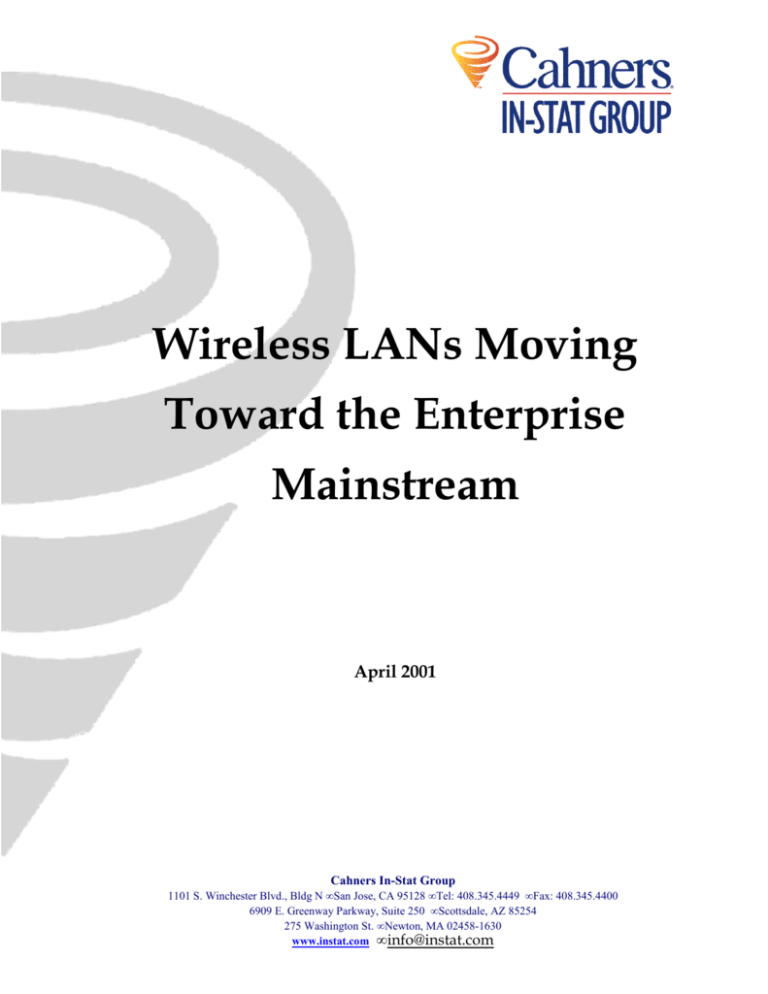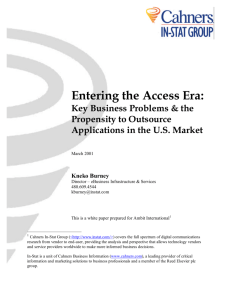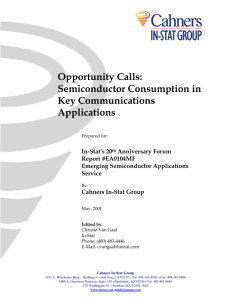
Wireless LANs Moving
Toward the Enterprise
Mainstream
April 2001
Cahners In-Stat Group
1101 S. Winchester Blvd., Bldg N • San Jose, CA 95128 • Tel: 408.345.4449 • Fax: 408.345.4400
6909 E. Greenway Parkway, Suite 250 • Scottsdale, AZ 85254
275 Washington St. • Newton, MA 02458-1630
www.instat.com • info@instat.com
© Copyright Cahners In-Stat Group, 2001. All rights reserved.
Reproduction in whole or part is prohibited without permission of Cahners In-Stat Group.
The contents of this report represent the interpretation and analysis of statistics and
information that is generally available to the public or released by responsible agencies or
individuals, but is not guaranteed as to its accuracy or completeness.
All Cahners In-Stat Group information is to be used only within the semiconductor and
related electronics industries and is not available to the general public. All information
received from Cahners In-Stat Group, either written or verbal, is to be considered
confidential and solely for internal use within the subscribing company. Cahners In-Stat
Group reserves the right to cancel your contract in full if our information is copied or
distributed to other divisions of the subscribing company without written approval from
Cahners In-Stat Group.
© 2000 Cahners In-Stat Group- www.instat.com
Wireless LANs Moving Toward the Enterprise
Mainstream
Formerly relegated to vertical markets such as retail, manufacturing and logistics,
the wireless LAN (WLAN) has begun to gain acceptance in many other enterprise
environments. The primary drivers of WLAN growth in 2000 and 2001 include the
education, healthcare, finance and hospitality markets. WLANs are attractive to
many organizations because they give employees considerable mobility, enabling
them to connect to corporate networks from anywhere on campus with ease.
WLANs also make it much easier for IT departments to add, move and change users'
network access specifications. That translates into substantial savings in time and
manpower.
Recent WLAN technological advances, including the release of Wi-Fi (802.11b)
products in late 1999 and 2000 from several prominent network equipment vendors,
have yielded higher speeds, improved interoperability and lower prices—key
qualities previously missing from the market. These developments are prompting
many IT managers to seriously consider implementing WLANs in their
organizations. Reflecting that newfound attitude, Cahners In-Stat Group expects the
market for WLAN equipment—NICs, access points and building-to-building
bridges—to skyrocket from $624 million in 1999 to $3 billion in 2002.
WLAN Niche Growing
WLANs serve distributed office environments with many branch offices—such as
insurance companies—particularly well. They are also convenient in areas with
limited infrastructure or cramped quarters, a common situation in Japan and Asia
Pacific.
In-Stat expects that most
enterprise environments will use
Wi-Fi technology (operating at
2.4 GHz yielding up to 11 Mbps)
mainly as an extension of their
wired networks. Although Wi-Fi
throughput is now roughly on
par with older 10Mbps Ethernet
throughput, it's still not adequate
for many enterprise settings
particularly those that use
multimedia data. In residential
and SOHO environments,
however, Wi-Fi provides for plenty of speed for downloading files, e-mail and
surfing the Web, allowing them to go completely wireless.
© 2001 Cahners In-Stat Group www.instat.com
1
Within a couple of years, new WLAN standards such as 802.11a and HiperLAN/2
will yield up to 54 Mbps, making the completely wireless enterprise more likely. Of
course, entrenched infrastructure technologies always die hard and much work
needs to be done before many enterprises rely on WLANs for most of their
networking needs. But, after many years of fits and starts, WLAN technology will
gain notable traction in the enterprise over the next couple of years.
WLAN Technology Has Long History
With its roots in spread spectrum technology developed by the U.S. military during
World War II, WLAN is not a new concept. In the 1980s, there were limited WLAN
applications but the technology really started to coalesce in the '90s after the FCC
assigned frequencies in ISM bands for commercial use. In 1997, the IEEE approved
the 802.11 standard and 2.4 GHz products entered the market creating momentum
for WLANs.
With the emergence of 802.11b products in 1999, WLAN technology finally dipped
its toes into mainstream markets. While the first WLAN standard, IEEE 802.11,
emerged in 1997, the existence of three different technologies within that standard
led to continued frustration for vendors and customers looking for true
interoperability. The ratification of the next generation, 802.11b standard (also called
802.11HR, or high rate), in September 1999, created a tidal wave of momentum from
traditional WLAN vendors as well as new entrants such as 3Com, Nokia, Ericsson,
Buffalo Technology, Siemens and Compaq. In November 1999, Cisco acquired
Aironet, a traditional WLAN vendor; this event in effect legitimized the WLAN
industry.
The force behind Wi-Fi's penetration into the enterprise is the Wireless Internet
Compatibility Alliance (WECA). The organization has spurred vendors to unite to
ensure interoperability, with the purpose of making 802.11b synonymous with "WiFi," much the same as 802.3 is synonymous with Ethernet. The marketing of Wi-Fi
has been crucial—vendors across the world, and across industry segments, have
joined WECA to ensure they keep up with the development of wireless networking.
The 802.11 Working Group has been working frantically to add heretofore undefined
sections to 802.11b, through the efforts of several Task Groups (TGs). 802.11TGe is
working on security issues while 802.11TGf is developing standards for inter-access
point protocol. Meanwhile, 802.11TGg is developing standards for higher speed
extensions (+20 Mbps) in the 2.4 GHz band.
Spread spectrum is the most common WLAN technology, but it is not the only one.
Others such as infrared and UHF (narrowband) have been used for years in WLAN
deployments, and newer technologies based on Orthogonal Frequency Division
Multiplexing (OFDM) in the 5 GHz frequency band will soon be unveiled to allow
for higher speeds.
2
© 2001 Cahners In-Stat Group www.instat.com
Technology in the 5 GHz band is currently under development and should debut
this year. Two competing standards for the next generation of WLANs, 802.11a and
HiperLAN/2, will operate in the 5 GHz band. The systems operating at 5 GHz will
operate at higher speeds using OFDM, but as of today, this technology has not
overcome physical hurdles related to the physical layer, such as the ability to pass
through walls and operate at a sufficient range. Outdoor bridges utilizing OFDM
technology are expected to enter the market in 2001. However, the technology is
extremely difficult to put into mobile devices, and 5 GHz NICs and APs are not
expected to ship until 2002, with volume shipments beginning in 2003. Additionally,
products made to work in this band will be quite expensive at the onset relative to 11
Mbps products.
Two Choices: Frequency Hopping or Direct Sequence
Spread spectrum uses two air interfaces: Frequency Hopping or Direct Sequence.
Direct Sequence Spread Spectrum (DSSS) works by transmitting data using a chip
sequence over a fixed frequency band, while Frequency Hopping (FHSS) uses a
technique that allows the signal to hop pseudorandomly up and down the band.
The debate has raged on for the last decade about which technology is better, but InStat believes that both techniques have merit.
The characteristics of DSSS technology are:
•
•
•
•
•
Higher range than FHSS.
Has higher data rates today with 11 Mbps product shipping. Signal is spread
using an 11-bit encryption code. This spreads the signal across a larger
segment of the available spectrum, which introduces the "processing gain"
that provides good noise and interference rejection.
Vendor interoperability within the 802.11b standard.
Continuous transmission allows higher data throughput.
Channels are separated by 5 MHz, and as a result adjacent channels overlap
and interfere with each other. APs on adjacent channels cannot be used in
close proximity to one another.
Some characteristics of FHSS technology include:
•
•
•
•
•
Lower cost radio technology (making it better suited for consumer
environments).
More scaleable due to ability to roam between access points on different
channels
Lower power.
Hopping provides noise immunity.
78 hopping patterns are available (in the US). Adjacent APs are extremely
unlikely to start the same hopping pattern at the exact same time, so mutual
interference is minimized.
© 2001 Cahners In-Stat Group www.instat.com
3
•
•
•
Many APs can co-exist in the same coverage area (15-20). This provides good
scalability, allowing many users to be supported within a confined space.
Resistance to interference. FH signal hops away from interference. Data
transmitted during a hop affected by interference will be re-transmitted on
some other channel.
Availability of WBFH products in 2001, with speeds up to 10 Mbps. These
will be backward compatible with HomeRF's current products.
The merits of each technology will continue to be debated, and different vendors will
generally argue (naturally) that the technology they use is the superior one.
Although the FCC approved Wide-Band Frequency Hopping (WBFH) in mid-2000,
In-Stat believes that Wi-Fi products will dominate the Enterprise WLAN market
through 2004, until 5 GHz technology becomes available at comparable prices.
The current momentum behind the DSSS products operating at 11 Mbps will tend to
drive out FH systems in the enterprise space. While Wi-Fi products are supported
by a host of networking, wireless, consumer electronics and silicon vendors, Proxim
is essentially the only vendor still pushing FH products into the enterprise space.
Furthermore, Proxim's WBFH products will not ship until 2001. Cisco (Aironet)
drastically reduced FH shipments for 1H 00, and shipped only trivial amounts in 2H
00, instead devoting all of its resources to Wi-Fi and future 5 GHz products.
Furthermore, if IEEE 802.11g is ratified and consequently the FCC moves to approve
this standard in a timely fashion, Wi-Fi's lifespan will increase.
Basic WLAN Architectures
WLAN technologies are implemented in two ways: peer-to-peer and access point
configuration. Peer-topeer is when the
different end clients
communicate directly
with one another. The
more popular WLAN
implementation is access
point configuration.
Generally, the access
point is the bridge for
the end clients, typically
a notebook PC in an
enterprise LAN, to get
on the wired network.
An access point is also
referred to as an indoor bridge. A typical ratio of NICs to access points is 5:1,
although this varies between vendors.
4
© 2001 Cahners In-Stat Group www.instat.com
Enterprises primarily acquire wireless LANs to enable mobility and to make adds,
moves and changes easier. Wireless LANs allow mobile workers the flexibility that
they require to use a complete suite of productivity tools while away from their
desks.
Wireless LANs connect PCs and other peripherals within a building, and wireless
bridges connect products between buildings. Wireless LAN access points create a
cell of roaming coverage for mobile users. By plugging in and configuring an access
point to attach to the wired backbone network, wireless LANs give wireless PCcard-equipped computers access to the company network. Overlapping cells of
coverage form when multiple access points exist around the floor or building. These
systems are helpful in environments where computers are mobile, where station
relocation occurs frequently or where it is difficult to lay cables.
For system operators, wireless bridging is less difficult than in-building wireless
LAN networking, because in-building wireless LAN networking involves more
variables, particularly users entering and leaving the access point cells.
Today's Challenges
Wireless LAN systems must be secure, manageable, scalable and cost-effective
(delivering improved price/performance over time). The most difficult challenge for
wireless networks is to measure up to standard enterprise networks' hardware and
software capabilities. A typical wired enterprise LAN operates on a switched Fast
Ethernet environment, with Gigabit Ethernet increasingly penetrating this space.
Additionally, management software options abound, as well as security applications
for the wired LAN network.
Price/Performance
Wireless LAN technology is really driven by a great desire for mobility. The highest
speeds available now are up to 11 Mbps, with actual throughput running at about
5.5 Mbps in good conditions, with fallback rates going down to 2 and 1 Mbps.
Wireless NICs, although falling to sub $200 prices in 2000, still are much more costly
than wired Fast Ethernet NICs, which have ASPs of approximately $45. Thus, the
need for mobility must be very high in order to compensate for the costly and rather
exotic features of wireless networking.
With the entrance of networking and wireless heavyweights such as Cisco, 3Com,
Intel, Nokia and Ericsson into the wireless LAN arena, prices will continue to fall.
These companies will use their expertise in volume shipping, as well as their
extensive and deep channels, to achieve quantities of scale and increase the demand
for WLAN products. Additionally, the entrance of low-cost, high volume vendors
such as D-Link and Linksys in the market has placed tremendous downward
pressure on prices.
© 2001 Cahners In-Stat Group www.instat.com
5
Another barrier to WLAN acceptance has been the labor cost of installing power
sources for the various APs positioned throughout the enterprise. This has
traditionally represented an additional cost of $1,000 per AP to the total cost of
installation. One cheaper solution has been to allow for power to be transferred over
Ethernet cables.
3Com has touted its power over Ethernet (PoE) as an attractive feature of its
AirConnect products. In October 2000, Lucent offered this same feature, calling it
Active Ethernet. Both companies developed their PoE functionalities in cooperation
with Power Dsine, which also developed this feature for Symbol. With PoE, system
installers only have to run a single Ethernet cable to each access point, instead of
separate power and data cables. In addition, IT managers no longer need to hire
electrical specialists to run dedicated AC power lines to individual APs.
Site surveys have become more precise and less burdensome with enhanced
applications from WLAN equipment vendors themselves, as well as specialty
vendors such as Wireless Valley, which provides tools for general wireless system
design, deployment and asset management.
Security
Wired Equivalent Privacy (WEP) is an option to the 802.11 standard, and is
incorporated almost universally into Wi-Fi products. The standard specifies an RC4
algorithm with a 40-bit key. When WEP is enabled, each station (clients and APs)
has up to four keys. The keys are used to encrypt the data before it is transmitted
through the airwaves. If a station receives a packet that is not encrypted with the
appropriate key, the packet will be discarded and never delivered to the host.
Although the 802.11 standard provides strong encryption services to secure the
WLAN, the means by which the secure keys are granted, revoked and refreshed is
undefined. However, several key administration architectures are available for use
in the enterprise. One approach for large networks is centralized key management,
which uses centralized encryption key servers. Encryption key servers provide for
centralized creation of keys, distribution of keys and ongoing key rotation. Key
servers enable the network administrator to command the creation of RSA
public/private key pairs at the client level that are required for client authentication.
As defined in the IEEE 802.11b standard in 1999, WEP (Wired Equivalent Privacy)
consists of two parts:
(1) Authentication: to solve the access control problem
• Open System—authenticate with no key (ESSID only)
• Shared Key—authenticate with a shared secret/key
(2) "Per-Packet" Encryption: to solve the data privacy problem
Drawbacks of WEP Security include issues with key management, where a shared
key is a single point of risk for all users (for example, when one lost key occurs, all
users have to change keys). Also, WEP has authentication holes, which allow it to be
6
© 2001 Cahners In-Stat Group www.instat.com
vulnerable to a "Man in the Middle Attack" and Denial of Service attacks. In
addition, the hacker community regards RC4-40 as a weak encryption.
Since WEP (layer 2) security has some well known issues, overall security can be
increased by applying other solutions in parallel, such as applying industry standard
IPSec at Layer 3. The IEEE 802.11 WG is working on security enhancements through
802.11 TGe.
Management
APs share the functions of both hubs and switches. Wireless clients associating with
APs share the wireless LAN, similar to the way a hub functions, but the AP can
additionally track movement of clients across its domain and permit or deny specific
traffic or clients from communicating through it. For network managers to use these
services to their advantage, it is necessary to instrument the AP like a hub and a
switch.
Most vendors provide for their WLAN devices to be manageable through common
Telnet or SNMP services and a Web browser interface to facilitate their monitoring
and control. In addition to bridge statistics and counters, APs from vendors such as
Cisco, Symbol and 3Com offer additional features such as mapping of APs and their
associated clients as well as monitoring and reporting of client statistics. APs can
also control access and the flow of traffic through the WLAN via MAC and protocollevel access lists.
Most vendors include management and traffic shaping applications with the
purchase of their WLAN products. For example, IT managers can leverage the
AirConnect Web-based administration to manage, monitor, and troubleshoot the
wireless LAN from any Web browser. They can also connect to access points with
Ethernet, wireless, or direct serial connections. AirConnect wireless LAN network
management software permits bulk distribution of configurations and profiles to
access points and wireless PCs on the same subnet. Symbol, however, has a very
comprehensive WLAN management application that it sells apart from its products.
Roaming
Although WLANs are intended to provide for enterprise mobility, there is no
industry standard that currently addresses the tracking or management of mobile
devices in its Management Information Base (MIB). This seemingly prohibits users
from roaming between wireless APs that cover a common area, such as a complete
floor of a building. However, individual vendors have addressed this issue,
providing their own versions of mobility algorithms that provide for roaming within
an IP domain (such as a floor) with an eye towards optimizing roaming across IP
domains (such as a campus environment).
Many vendors offer access point solutions that provide load balancing and roaming,
which enable multiple access points to provide seamless campus-wide coverage.
802.11TGf is working on defining inter AP protocol. Most leading vendors allow for
© 2001 Cahners In-Stat Group www.instat.com
7
access points to support roaming across multiple access points on the same subnet,
as well as DHCP and Extended Roaming, allowing users to move seamlessly
between Access Points on different subnets.
Conclusion:
The increasing mobility of today’s lifestyle is largely due to the
advent of wireless communications technology. From wireless
handsets enabled by analog cellular, PCS, DECT and digital cellular,
to local connectivity enabled by infrared and new technologies such
as Bluetooth, the ability to transmit voice and data signals over
wireless links has spurred an explosion of new devices to take
advantage of this newfound freedom. The enterprise is no
exception. Increasingly, enterprises will take advantage of wireless
technology to connect to the wired LAN and someday rely on it for
even more of their network traffic.
For further information, see the following Cahners In-Stat Group
reports:
Wild on Wireless Networking: WLAN Market Young, Energetic and
Growing http://www.instat.com/catalog/cat-ln.htm
Bluetooth 2001 http://www.instat.com/catalog/cat-mm.htm
Bluetooth & Wi-Fi: The Crusade for Coexistence
http://www.instat.com/catalog/cat-ln.htm#ln0101wl
John Q. Public Gets Connected: The Emerging Public Space
Broadband Access Market http://www.instat.com/catalog/catmtb.htm#mu0102sg
2000 Enterprise Wireless LAN Market Update (#LN0011WL)
http://www.instat.com/abstracts/ln/2000/ln0011wl_abs.htm
Pass the Chips: A Home Network Chipset Market Analysis (#NT0009HN)
http://www.instat.com/abstracts/rc/2000/rc0009hn_abs.htm
Wireless LAN IC Markets: Untethering the Enterprise (#WT0001WL)
HTTP://WWW.INSTAT.COM/CATALOG/CAT-WT.HTM#WT0001WL
8
© 2001 Cahners In-Stat Group www.instat.com
Cahners In-Stat Group covers the full spectrum of digital communications
research from technology to end-user, providing the analysis and
perspective that allows technology vendors and service providers
worldwide to make more informed business decisions.
In-Stat's digital communications research provides complete coverage of
data, voice, and video communications, from wireless to wireline,
computing to Internet, consumers to businesses. Comprehensive research
covering the entire value chain.
Cahners In-Stat Group stands alone in its ability to integrate both supplyside and demand-side research methodologies into a single comprehensive
view of a market place. This capability relies on our unique ability to cover
the entire value chain from baseline technology, through equipment,
infrastructure, services and end-users.
• Our quantitative and qualitative analysis at each stage of the value
chain elevates our market knowledge and forecasting ability for all
market segments.
• Our expertise in the semiconductor markets qualifies us to accurately
predict feature sets, capabilities and price points for equipment and
infrastructure.
• Our statistically accurate surveys of businesses and consumers
enables us to compare budgets and purchasing behavior to market
acceptance, sales and unit forecasts.
© 2001 Cahners In-Stat Group www.instat.com
9
•
Capping it all is our unique ability to segment technology markets
by size of business and identifying specific opportunities.
Don't trust your business plan with anything less than In-Stat's
comprehensive market coverage!
Unparalleled Customer service
Cahners In-Stat Group maintains direct access between our clients and
analysts. No barriers, no gatekeepers. Our analysts are extremely responsive
to customer inquiries, usually responding within 24 hours -- a key customer
advantage. When you need immediate information, only Cahners In-Stat
Group provides direct, immediate analyst contact.
The Cahners In-Stat Group Advantage
Cahners In-Stat Group, as part of Reed Elsevier Global Information
Network, is a strategic piece of a $5 billion global information network. We
have access to a worldwide electronic network, databases and personnel, all
of which contribute to exceptional insight into individual geographic
marketplaces such as Europe and the Pacific Rim, and technology areas such
as electronics, cable and wireless. As a member of Cahners Business
Information, we are a core segment of the largest business-to-business
information provider in the world.
10
© 2001 Cahners In-Stat Group www.instat.com










